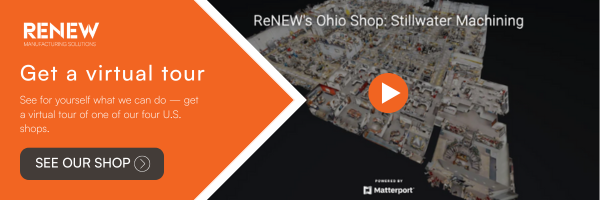Lessons for 2026: 5 Supplier Red Flags That Could Cost You

2025 was a turbulent year for manufacturing.
Tariffs spiked. Supplier lead times stretched. AI adoption accelerated. Capacity shifted across regions. For many OEMs, uncertainty became the norm. But turbulence doesn’t have to mean chaos. The right manufacturing partner helps you stay ahead of the curve, not just react to it.
From our experience navigating 2025, we’ve identified 5 supplier red flags every OEM should watch for.
It’s important to understand what they are, why they matter to your bottom line, and how to spot them early before they cost you time, money, or market share.
Red flag #1: Relying on outdated equipment and manual processes
Manufacturing technology is advancing fast.
Machines and software that “still work” may not be competitive anymore. Older equipment and manual workflows increase the risk of defects, slow changeovers, higher costs, and less flexibility.
These are all vulnerabilities that directly impact your schedule and quality.
Despite economic uncertainty, investment in advanced equipment remains strong. Companies are modernizing to maintain precision, speed, and cost efficiency. For example, we recently added a new laser at our Pennsylvania facility and a Mazak Turning Center at our Ohio facility to expand capacity and precision capabilities.
What to ask your supplier
- When was your last major equipment investment?
- What’s your typical changeover time on key parts or machines?
- What tolerances or throughput improvements did you achieve with your latest upgrades?
How you’ll know a partner is ready
- Provides data on lead time or defect reduction
- Can demonstrate multi-axis or multi-function capabilities
- Explains how their equipment investments improve responsiveness and reliability
Red flag #2: No digital/AI strategy or transparent systems
Digital transformation is no longer optional.
Without modern systems for scheduling, tracking, and AI-driven inspection or maintenance, suppliers lose visibility and control. And you lose reliability.
In 2025, most manufacturers recognized AI as a strategic priority, yet only about half had a plan in place. That gap creates significant performance and risk differences between suppliers.
What to ask your supplier
- What software do you use for job tracking, scheduling, and quality data?
- Does your system leverage AI, and how often is it updated?
- Can we access real-time visibility into order status, lead time changes, and quality metrics?
How you'll know a partner is ready
- Offers dashboards and transparent reporting
- Speaks fluently about how data and automation improve your outcomes
- Uses AI-driven insights to reduce downtime and improve quality consistency
Red flag #3: Single-site or capacity-constrained supplier
If your supplier operates from only one facility, disruptions such as equipment breakdowns, labor shortages, or local regulations become your risk.
Multi-site operations provide built-in redundancy, flexibility, and scalability.
In 2025, as supplier delivery indexes and lead times rose, more OEMs began prioritizing regional diversification to strengthen their supply chains.
What to ask your supplier
- How many production sites do you operate, and how do you coordinate capacity across them?
- How often have you shifted work between facilities in the past year?
- What systems or processes ensure backup or surge capacity?
How you'll know a partner is ready
- Maintains consistent processes and metrics across locations
- Offers virtual tours or audit transparency
- Demonstrates the ability to scale or shift work quickly
Red flag #4: Lack of transparent communication
In unpredictable times, communication is everything.
You need a supplier who acts as a true partner: Proactively updating you on project status, challenges, and solutions.
When visibility is low, risk is high.
With tariffs, shipping delays, and supply volatility all increasing in 2025, transparency became one of the most valuable traits in supplier relationships.
What to ask your supplier
- Can we access live or periodic updates on job status and quality metrics?
- Do you offer virtual facility tours or remote audit capabilities?
- How do you communicate when disruptions occur?
How you'll know a partner is ready
- Provides a clear communication cadence
- Offers portal access or visual dashboards
- Demonstrates proactive risk management and updates
Red flag #5: Workforce instability or skill gaps
Even the most advanced technology depends on skilled people to operate it.
High turnover, an aging workforce, or minimal training can create risks for quality, consistency, and innovation. The manufacturing labor market remains tight, and skilled operators and data-savvy technicians are in high demand.
What to ask your supplier
- What’s your annual turnover rate for production or engineering staff?
- What training or hiring investments have you made recently?
- How do you ensure your team stays current with AI, automation, and new equipment?
How you'll know a partner is ready
- Demonstrates structured training and retention programs
- Highlights recent hires or certifications
- Can explain how their team’s expertise supports your long-term success
From caution to confidence: What green flags look like in 2026
As we enter 2026, the manufacturing landscape continues to evolve.
Tariff pressures, supply chain realignments, and digital transformation will continue shaping how OEMs select and manage suppliers.
But unpredictability doesn’t have to mean instability.
Choosing partners with modern equipment, digital systems, multi-site operations, clear communication, and a skilled workforce will help you stay resilient and competitive.
At Renew Manufacturing Solutions, we understand these dynamics.
Our investment in people, technology, and machines ensures you get the stability, speed, transparency, and quality your business demands.
Take a virtual site tour of one of our four facilities, request a quote, or talk with our team about how we can support your next manufacturing project.




